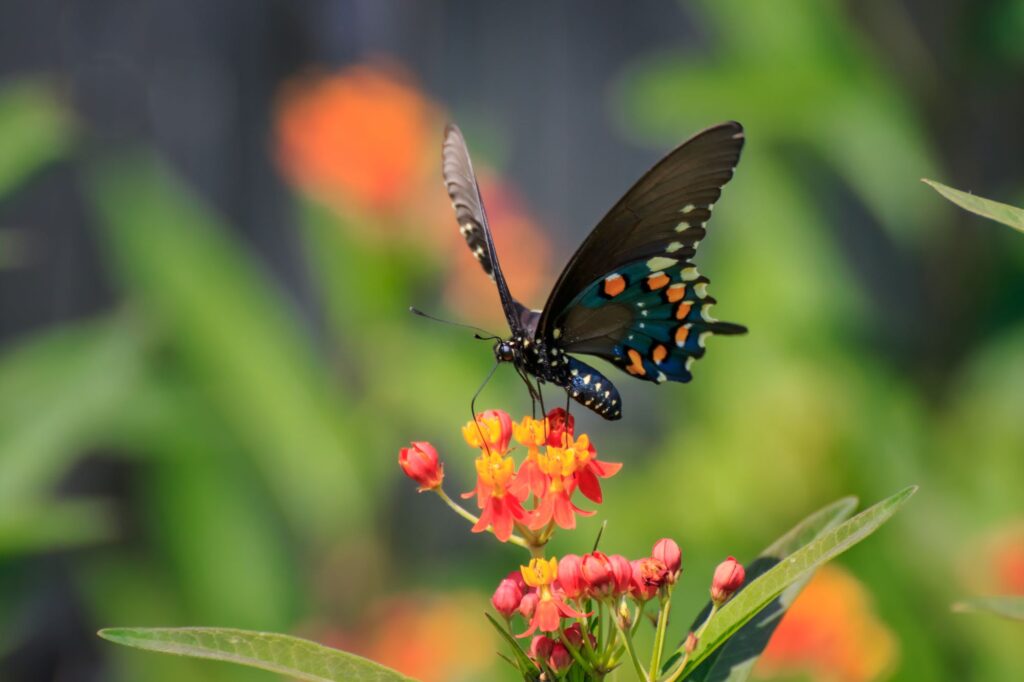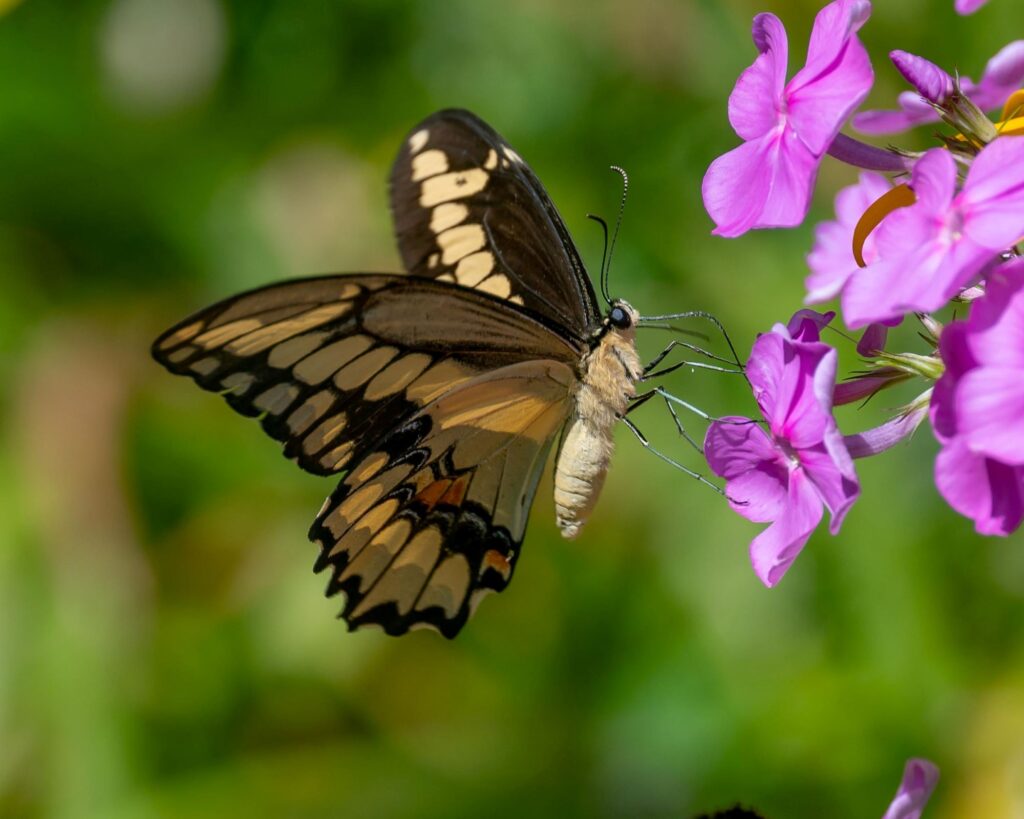
Missouri’s diverse and unique Midwest landscapes provide a home for a variety of native butterflies, each playing an important role in the local ecosystem. From the delicate monarch to the vibrant eastern tiger swallowtail, these winged wonders grace our skies and gardens throughout the year.
Join us as we explore the enchanting world of Missouri’s native butterflies at Powell Gardens, Kansas City’s botanical garden, and discover how you can support them in your own backyard.
Butterfly Life Cycle
Understanding the life cycle of Missouri’s butterflies is key to appreciating their journey from egg to adult. Here’s a brief overview of their complete metamorphosis.
Egg
The life cycle of every butterfly begins when a female butterfly lays eggs on a specific host plant. Each species of butterfly has preferred plants where they lay their eggs, ensuring the caterpillars have suitable food upon hatching. For example, a monarch butterfly lays their eggs on Milkweed.
Caterpillar (Larva)
Once hatched, caterpillars spend their time eating and growing. Caterpillars molt (shed) several times as they outgrow their exoskeletons. Their sole purpose during this stage of life is to consume and store energy for the next phase.
Pupa (Chrysalis)
After the caterpillar reaches full size, it forms a chrysalis or pupa. Inside this protective casing, the caterpillar undergoes a remarkable transformation, breaking down and reorganizing its body into the structure of an adult butterfly.
Adult Butterfly
Finally, the adult butterfly emerges from the chrysalis, ready to mate and continue the life cycle. Adult butterflies play a crucial role in pollination as they feed on nectar from flowers, contributing to plant reproduction and biodiversity.
Butterflies as Pollinators
Butterflies play a critical role in pollination, contributing to the reproduction of numerous plant species across ecosystems. As they flit from flower to flower in search of nectar, butterflies inadvertently transfer pollen grains between plants. This process, known as pollination, is essential for producing fruits, seeds, and new plants.
By facilitating cross-pollination, butterflies help maintain genetic diversity within plant populations, which is crucial for their resilience and adaptation to environmental changes. In this way, butterflies are not only icons of beauty but also indispensable contributors to the health and biodiversity of our natural landscapes.
Missouri’s Native Butterflies
In Missouri, you can encounter a variety of native butterflies, each adapted to different habitats and food sources. Learn about some Powell Gardens’ favorites below!

Monarch Butterfly (Danaus plexippus)
Known for its epic migration from Mexico to the northern United States and Canada, monarchs rely on milkweed plants as their host for egg laying and caterpillar food.

Eastern Tiger Swallowtail (Papilio glaucus)
This large, yellow and black butterfly is common in Missouri gardens, where it feeds on various flowers including milkweed, lilac, and butterfly bush.

Pipevine Swallowtail (Battus philenor)
Named for its preferred host plant, the pipevine, this butterfly is characterized by its iridescent blue wings with black spots.

Red-spotted Purple (Limenitis arthemis)
Often mistaken for the pipevine swallowtail, this butterfly has dark wings adorned with red spots and is found in forests and woodland edges where it feeds on tree sap and rotting fruit.

Giant Swallowtail (Papilio cresphontes)
This butterfly is North America’s largest butterfly. The wingspan can reach up to 6” across. Females are typically larger than males. This butterfly is black with yellow lines and the under wings are mostly yellow with some black lines.
How to Help Butterflies in Home Gardens
Creating a butterfly-friendly garden not only enhances your outdoor space but also provides essential habitat and resources for these beautiful insects. Here are some tips to attract and support butterflies in your garden.
Plant Native Plants
Choose native plants that serve as host plants for butterfly eggs and caterpillars, such as milkweed for monarchs, pipevine for pipevine swallowtails, and parsley for black swallowtails.
Provide Nectar Sources
Include a variety of flowering plants that provide nectar throughout the growing season. Butterflies are particularly attracted to bright, fragrant flowers like butterfly bush, coneflowers, bee balm, and asters.
Avoid Pesticides
Minimize or eliminate the use of pesticides in your garden, as they can harm butterflies and their larvae. Instead, opt for natural pest control methods or tolerate a certain level of plant damage.
Provide Shelter and Water
Butterflies need shelter from wind and rain, so consider planting shrubs or providing butterfly houses. A shallow dish with wet sand or rocks can also serve as a butterfly watering station.
Create Sunlit Areas
Butterflies are ectothermic (cold-blooded) and rely on sunlight to regulate their body temperature. Ensure there are sunny spots in your garden where butterflies can bask and warm up.
By embracing Missouri’s native butterflies and creating welcoming habitats in our gardens, we not only enhance our natural surroundings but also contribute to the conservation of these iconic pollinators. Let’s celebrate their beauty and significance as we cultivate gardens that sustain them for generations to come.
Celebrate Butterflies This Summer with Festival of Butterflies
Each summer, butterflies steal the show at Powell Gardens! Join us for Festival of Butterflies where you can have up-close encounters with butterflies, learn about pollination and native plants, and enjoy special events.
Related Posts
